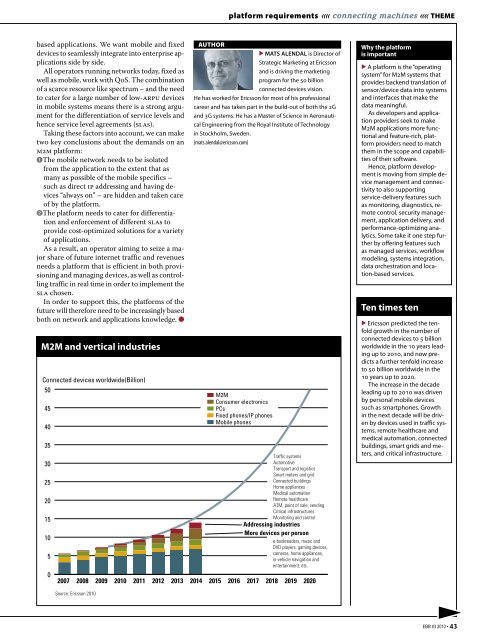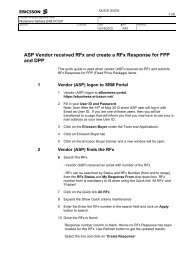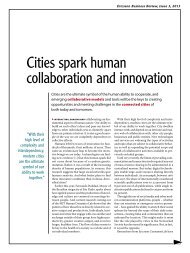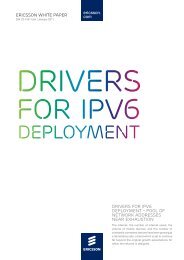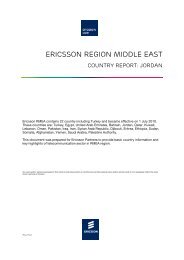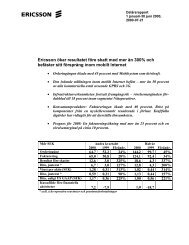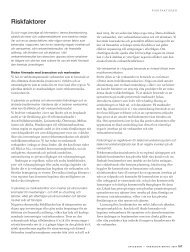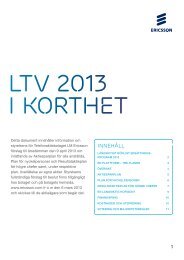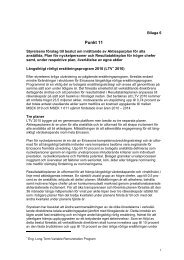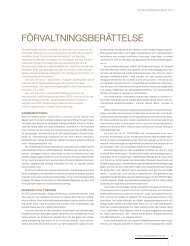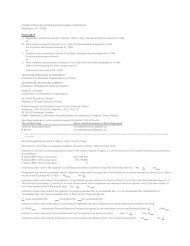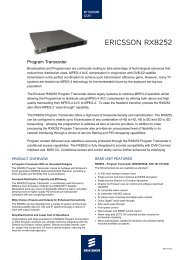Telenor's - Ericsson
Telenor's - Ericsson
Telenor's - Ericsson
- TAGS
- ericsson
- www.ericsson.com
Create successful ePaper yourself
Turn your PDF publications into a flip-book with our unique Google optimized e-Paper software.
ased applications. We want mobile and fixed<br />
devices to seamlessly integrate into enterprise applications<br />
side by side.<br />
All operators running networks today, fixed as<br />
well as mobile, work with QoS. The combination<br />
of a scarce resource like spectrum – and the need<br />
to cater for a large number of low-arpu devices<br />
in mobile systems means there is a strong argument<br />
for the differentiation of service levels and<br />
hence service level agreements (slas).<br />
Taking these factors into account, we can make<br />
two key conclusions about the demands on an<br />
m2m platform:<br />
�The mobile network needs to be isolated<br />
from the application to the extent that as<br />
many as possible of the mobile specifics –<br />
such as direct ip addressing and having devices<br />
“always on” – are hidden and taken care<br />
of by the platform.<br />
�The platform needs to cater for differentiation<br />
and enforcement of different slas to<br />
provide cost-optimized solutions for a variety<br />
of applications.<br />
As a result, an operator aiming to seize a major<br />
share of future internet traffic and revenues<br />
needs a platform that is efficient in both provisioning<br />
and managing devices, as well as controlling<br />
traffic in real time in order to implement the<br />
sla chosen.<br />
In order to support this, the platforms of the<br />
future will therefore need to be increasingly based<br />
both on network and applications knowledge. ●<br />
M2M and vertical industries<br />
Connected devices worldwide(Billion)<br />
50<br />
45<br />
40<br />
35<br />
30<br />
25<br />
20<br />
15<br />
10<br />
5<br />
0<br />
2007<br />
platform requirements «« connecting machines «« THEME<br />
M2M<br />
Consumer electronics<br />
PCs<br />
Fixed phones/IP phones<br />
Mobile phones<br />
Traffic systems<br />
Automotive<br />
Transport and logistics<br />
Smart meters and grid<br />
Connected buildings<br />
Home appliances<br />
Medical automation<br />
Remote healthcare<br />
ATM, point of sale, vending<br />
Critical infrastructures<br />
Monitoring and control<br />
Addressing industries<br />
More devices per person<br />
e-bookreaders, music and<br />
DVD players, gaming devices,<br />
cameras, home appliances,<br />
in-vehicle navigation and<br />
entertainment, etc.<br />
2008 2009 2010 2011 2012 2013 2014 2015 2016 2017 2018 2019 2020<br />
Source: <strong>Ericsson</strong> 2010<br />
AUTHOR<br />
▶ MATS ALENDAL is Director of<br />
Strategic Marketing at <strong>Ericsson</strong><br />
and is driving the marketing<br />
program for the 50 billion<br />
connected devices vision.<br />
He has worked for <strong>Ericsson</strong> for most of his professional<br />
career and has taken part in the build-out of both the 2G<br />
and 3G systems. He has a Master of Science in Aeronautical<br />
Engineering from the Royal Institute of Technology<br />
in Stockholm, Sweden.<br />
(mats.alendal@ericsson.com)<br />
Why the platform<br />
is important<br />
▶ A platform is the “operating<br />
system” for M2M systems that<br />
provides backend translation of<br />
sensor/device data into systems<br />
and interfaces that make the<br />
data meaningful.<br />
As developers and application<br />
providers seek to make<br />
M2M applications more functional<br />
and feature-rich, platform<br />
providers need to match<br />
them in the scope and capabilities<br />
of their software.<br />
Hence, platform development<br />
is moving from simple device<br />
management and connectivity<br />
to also supporting<br />
service-delivery features such<br />
as monitoring, diagnostics, remote<br />
control, security management,<br />
application delivery, and<br />
performance-optimizing analytics.<br />
Some take it one step further<br />
by off ering features such<br />
as managed services, workfl ow<br />
modeling, systems integration,<br />
data orchestration and location-based<br />
services.<br />
Ten times ten<br />
▶ <strong>Ericsson</strong> predicted the tenfold<br />
growth in the number of<br />
connected devices to 5 billion<br />
worldwide in the 10 years leading<br />
up to 2010, and now predicts<br />
a further tenfold increase<br />
to 50 billion worldwide in the<br />
10 years up to 2020.<br />
The increase in the decade<br />
leading up to 2010 was driven<br />
by personal mobile devices<br />
such as smartphones. Growth<br />
in the next decade will be driven<br />
by devices used in traffi c systems,<br />
remote healthcare and<br />
medical automation, connected<br />
buildings, smart grids and meters,<br />
and critical infrastructure.<br />
▶<br />
EBR #3 2010 43


